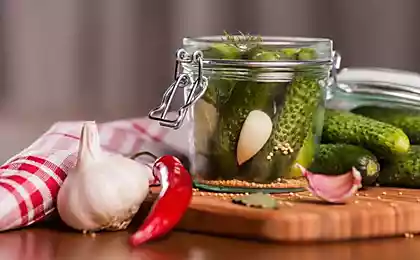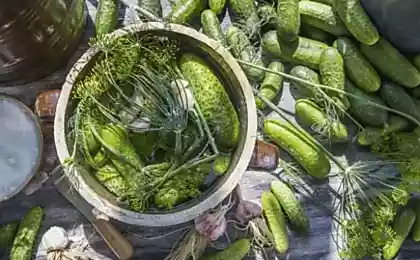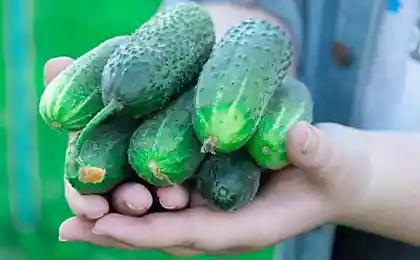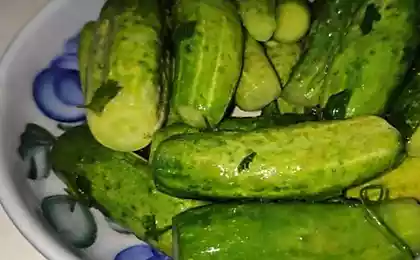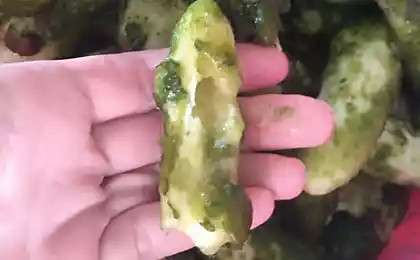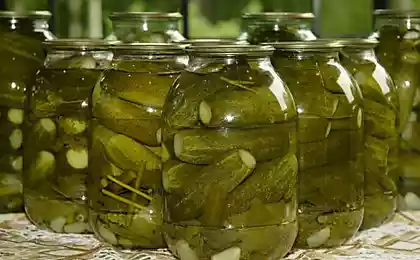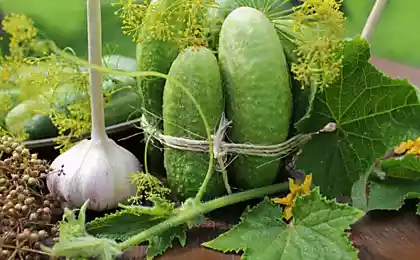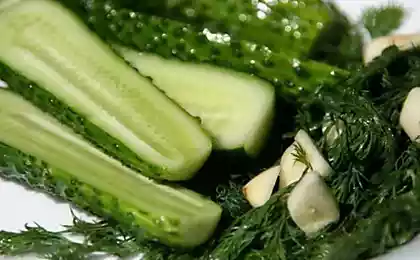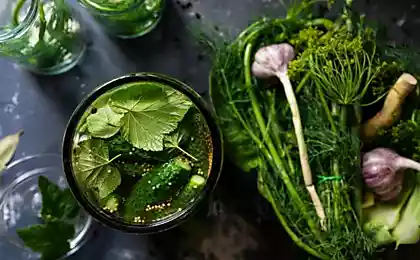659
Unusual cucumbers and their exotic relatives
Cucumber is a traditional and familiar vegetable. And it would seem, surprise he can't do anything. But thanks to breeders, there are new unusual varieties: white and yellow, very tiny and gigantic...
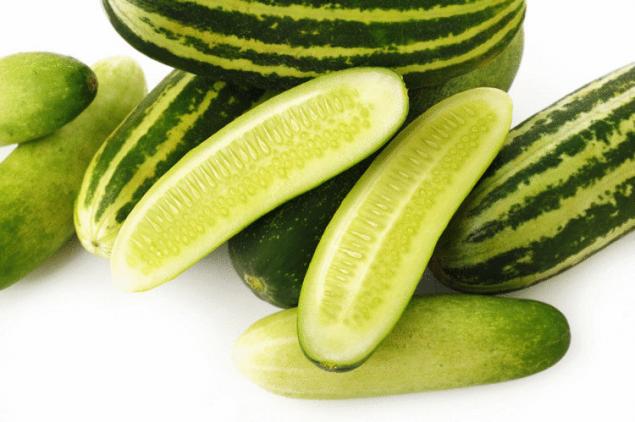
Gardeners are happy experimenting, testing innovations in practice. Our readers have already shared my experience: note the unusual Cucumbers okraski the review it is possible to gather useful information. But this indefatigable naturalists little! And gardens is situated, in addition to the usual cucumbers, and their exotic relatives of the gourd family — melothria, trigonant, MOMORDICA, and others. Let's look at them a little closer...
Chinese cucumbers, these cucumbers Chinese name because of origin, since they come from China, but the varieties there are quite a lot. Most popular: Chinese snake, Chinese disease-resistant, Chinese white, Chinese farmer F1, dlinnoplodnye Chinese and the Chinese miracle.
Stem Chinese cucumber can have around 3.5 meters in length, and fruit (depending on variety) reach 40-90 cm in length. But they hit not so impressive in size, as the ease of cultivation and excellent taste. These pickles are very good, absolutely not whimsical, almost not affected by pests and almost sick.
They are well cultivated in the open ground and in greenhouses or greenhouses; equally well feel on the sun and in partial shade. Moreover, some special care of it is not required, the only all varieties of Chinese cucumbers need support, so they grow better and the fruits give a more correct form. And the rest, Chinese cucumber apply the same farming techniques that conventional: timely weeding, intermittent watering, fertilizing, etc., as you can read in the article Cucumber — secrets of cultivation.
Fruit Chinese cucumbers before the first frost. Their fruit never taste bitter and are extremely delicate, slightly sweet flavor and wonderful aroma, slightly reminiscent of a watermelon. By the way, the fruit of Chinese cucumber malnutrition affects immediately. What does the shape of a Chinese cucumber attentive gardener? About the elements of nutrition that the plant is not enough:
Armenian cucumbers are the Owner of a rather exotic species, Armenian cucumber, came to us from Central Asia, also has several varieties. The most popular of them: hero white, Chalk it Flehi-ASUS and Melon Silver.
All varieties of Armenian cucumber grow well in the open field and film greenhouses. Taste of fruit quality, reaching 50 cm in length, is less pronounced than that of the Chinese cucumbers, and the fruits, whose weight may reach 1 kg, regardless of grade, entirely covered with silvery-white pubescence.
Whip these cucumbers can reach 4 meters in length, so in need of construction support. The value of the Armenian cucumber is long fruiting, resistance to disease and temperature extremes.
Italian cucumbers Again, as in the case of Chinese, Italian, these pickles call for country of origin. Being a real Italian miracle of breeding, these cucumbers in appearance very similar to Armenian. The most popular varieties of Italian cucumbers that are cultivated in the Middle lane are Arbusse (Tortorello) and Barrese (both pollinated by bees).
The fruit varieties Arbusse (Tortorello), with light-green skin and a pronounced ribbing, can reach 50 cm in length. The flavor is a little sweet — something between a cucumber and watermelon.
Grade Barrese is also characterized by a pronounced ribbing, but, in contrast to the varieties of Arbusse, its fruits are dark green color, which is the ripening changes to orange-yellow. The taste and aroma of the fruit varieties Barrese more like a melon.
Cucumber-lemon Cucumber-lemon — a sort of 'Crystal Apple' is not afraid of the word, masterpiece work of English breeders. The variety is unusual in that its ripe fruit in appearance very similar to the lemon, although the taste they have nothing in common with this citrus not.
Cucumber-lemon is best grown through seedlings, it is very heat - and moisture-loving. Stem plants are able to reach a length of 6 meters and a bit more about it you can learn by reading this helpful note.
White cucumber White cucumbers are called these because of the unusual color of the fruit. Most popular varieties include the Snow leopard, the Bride, White angel, Snow white, Three white sheet and Italian white.
White cucumbers form a long whip. They are suitable for growing both outdoors and in the greenhouse. Resistant to diseases, able to withstand high temperatures up to +45°C, making them particularly attractive for cultivation in hot regions.
White cucumber fruits reach only 20 cm in length, they taste more tender than a regular cucumber, and slightly sweet. White cucumbers grow very quickly, keep this in mind deciding to grow them.
Melothria rough, or mini-cucumber Melothria rough, or mini-cucumber belongs to the same family as regular cucumber, Pumpkin. Perennial vine native to Africa, melothria in the Middle zone it is grown mainly through seedlings and only as an annual plant.
For growing seedlings of suitable universal land substrate. Small seeds melothria to fill the earth just needs a little, then under optimal temperature (about +25...+27 ° C) they germinate already at 5-7 days. Seedlings are easily transferred to transplant, and within a few weeks grow to unprecedented sizes: in length they can reach up to 3 meters and therefore need support. By the way, transplanting the seedlings melodii in the open ground, make them the most Sunny area with loose soil. At least once in 4-5 days, watering plants, and every 10-14 days, feed the plant, alternating organic fertilization with mineral.
Especially appreciated melothria not so much for taste its fruit, how much for an expressive and very decorative appearance: deep green leaves of the plant do not lose their color until autumn. Although the fruits melothria similar to tiny (1.5-2.5 cm) watermelon, it is edible. The taste they resemble ordinary cucumbers and just like cucumbers are quite suitable for further processing: pickling and canning. By the way, the first fruits melothria will be available for 14-18 days after planting plants in the ground.
Indian cucumber — MOMORDICA is Another exotic relative of the cucumber — MOMORDICA, or the Indian cucumber. Successfully grow the MOMORDICA can not only outdoors, but also on the windowsill. Perhaps, this, of course, the exotic look of this plant made it recently popular among gardeners.
To grow the MOMORDICA can be anyone, because it is not difficult. However, there are some subtleties that must be taken into account. Before you sow the seeds of the Vietnamese the land in the substrate, they must scarify — just RUB the sharp tip of the seed on a piece of sandpaper. And after scarification, the seeds should be decontaminated (how to do it is described here in this useful article).
After conducting pre-treatment: scarification and disinfection seeds — the Vietnamese have put pre-moistened cloth or toilet paper and place in a warm place (temperature about +25°C), so that they will sprout much faster. Having spent quite a bit of time and processed the seeds of the Vietnamese in this way, you will significantly increase germination.
After the seed shell will crack, it can be sown in pots for growing seedlings. Nutritious potting mix for growing the Vietnamese become ready or prepared yourself by mixing 10 kg (about a bucket) of the earth with your garden with 10 kg sand and 5 kg of rotted leaves. While seeds will not germinate, the earth should not be dry, so always make sure that she was moderately wet.
Since MOMORDICA is a thermophilic plant, planted in open ground it is necessary not earlier, than in second half of may. Transplanted young, more immature plants together with a lump of earth, so as not to damage the delicate roots. After planting every 2-3 weeks feeding the MOMORDICA yeast nutrient solution, having dissolved 10 g of yeast in 1 liter of water.
It will take quite a bit of time after planting in the ground, and MOMORDICA will thank you for proper care gorgeous view of its decorative foliage, bright yellow flowers, smelling of Jasmine, and a little later an exotic species of fruit.
The fruits of the Vietnamese lumpy, and as you grow they change their color from dark green to bright orange. But this is not their only feature. The secret fruits of the Vietnamese lies in their form, which changes as they Mature. Ripen, they expand and become outwardly very similar to the crocodile open his mouth, from which peep out bright crimson seeds, covered with a dense jelly-like pulp. By the way, for such surprising similarity of the MOMORDICA called "cucumber-crocodile".
Trigonant — serpentine cucumber Another representative of the pumpkin — trigonant, more often called snake-like cucumber. In South-East Asia trigonant cultivated as a vegetable crop. We distributed a little while, but numerous fans of exotic pleasure to grow such an unusual cucumbers on their sites and appreciate trigonant not only for exotic species, but also the ruggedness, and resistance to diseases and pests.
Trichosantha the fruits are cylindrical in shape and in length can reach a length of 1 m 20 cm... But trigonant surprises not only with its length: its fruits squirm like serpents, and as they Mature change colour from green to bright red-orange. Flowers trichosantha too unusual look: a fairly small — diameter reaching 4 cm — they look like weightless snowflakes.
Given that trigonant very heat-loving, it is better to grow seedlings. Seeds are sown in the same land substrate, and for growing cucumbers from 10 may. For permanent seedlings planted in early June. In the Middle zone it can be grown only in greenhouses but not in open field — keep this in mind, deciding to acquire such a rarity.
Thladiantha dubious red cucumber Perennial climbing vine, reaching 5 meters in height, thladiantha doubtful native of South-East Asia. The plant has heart-shaped leaves are light green and bright yellow flowers profusely covering the vine. They bloom all summer long, and resemble tulips.
On location of colors with the time of the formation of small fruits, which are used for preservation and pickling, but only until such time until they reach 15 cm and begins to change its color. As soon as the fruit tladianty questionable ripen and turn red, they become very sweet, and they begin to jam.
Although to achieve fruiting, especially in the first year of life plants in the Middle band is not so easy: female plants develop later, causing the fruit simply did not have time to ripen. In addition, the home of tladianty pollinating insects, which we do not. It turns out that domestic gardeners are forced to spend the pollination manually.
Tladianty propagated not only by seeds but also tubers resembling potatoes. Very small seeds tladianty (smaller than poppy seeds), sown seedlings in early March. Before sowing they must strategicgrowth. Thladiantha well developed even with a small light, so the seedlings in the supplementary lighting do not need and safely grow at low temperatures. Therefore the plant can be grown in warmed loggia or balcony, make sure the temperature never dropped below 0°C. soil grown seedlings are planted in tladianty after being bypassed spring frost in late may or early June.
Reproducing tladianty tubers, remember that the plant needs frequent watering, but at the same time, can quickly die from waterlogged soil. Plant tubers at a depth of about 8-10 cm around the middle of April. Seedlings emerge by the middle of may, followed by a fairly rapid growth. Thus, in Sunny weather, shoots tladianty can grow by as much as 15 cm in Autumn, the aerial part of the plant dies and forms large underground tubers. Without a transplant, in one place thladiantha can grow for about 10 years.
Source: www.7dach.ru

Gardeners are happy experimenting, testing innovations in practice. Our readers have already shared my experience: note the unusual Cucumbers okraski the review it is possible to gather useful information. But this indefatigable naturalists little! And gardens is situated, in addition to the usual cucumbers, and their exotic relatives of the gourd family — melothria, trigonant, MOMORDICA, and others. Let's look at them a little closer...
Chinese cucumbers, these cucumbers Chinese name because of origin, since they come from China, but the varieties there are quite a lot. Most popular: Chinese snake, Chinese disease-resistant, Chinese white, Chinese farmer F1, dlinnoplodnye Chinese and the Chinese miracle.
Stem Chinese cucumber can have around 3.5 meters in length, and fruit (depending on variety) reach 40-90 cm in length. But they hit not so impressive in size, as the ease of cultivation and excellent taste. These pickles are very good, absolutely not whimsical, almost not affected by pests and almost sick.
They are well cultivated in the open ground and in greenhouses or greenhouses; equally well feel on the sun and in partial shade. Moreover, some special care of it is not required, the only all varieties of Chinese cucumbers need support, so they grow better and the fruits give a more correct form. And the rest, Chinese cucumber apply the same farming techniques that conventional: timely weeding, intermittent watering, fertilizing, etc., as you can read in the article Cucumber — secrets of cultivation.
Fruit Chinese cucumbers before the first frost. Their fruit never taste bitter and are extremely delicate, slightly sweet flavor and wonderful aroma, slightly reminiscent of a watermelon. By the way, the fruit of Chinese cucumber malnutrition affects immediately. What does the shape of a Chinese cucumber attentive gardener? About the elements of nutrition that the plant is not enough:
- hook form purchase cucumbers with a lack of nitrogen;
- they become too thin due to the lack of boron;
- pear-shaped fruits are lacking in potassium;
- lack of calcium will make the cucumbers are tasteless and small, so a root or foliar feeding is best done regularly.
Armenian cucumbers are the Owner of a rather exotic species, Armenian cucumber, came to us from Central Asia, also has several varieties. The most popular of them: hero white, Chalk it Flehi-ASUS and Melon Silver.
All varieties of Armenian cucumber grow well in the open field and film greenhouses. Taste of fruit quality, reaching 50 cm in length, is less pronounced than that of the Chinese cucumbers, and the fruits, whose weight may reach 1 kg, regardless of grade, entirely covered with silvery-white pubescence.
Whip these cucumbers can reach 4 meters in length, so in need of construction support. The value of the Armenian cucumber is long fruiting, resistance to disease and temperature extremes.
Italian cucumbers Again, as in the case of Chinese, Italian, these pickles call for country of origin. Being a real Italian miracle of breeding, these cucumbers in appearance very similar to Armenian. The most popular varieties of Italian cucumbers that are cultivated in the Middle lane are Arbusse (Tortorello) and Barrese (both pollinated by bees).
The fruit varieties Arbusse (Tortorello), with light-green skin and a pronounced ribbing, can reach 50 cm in length. The flavor is a little sweet — something between a cucumber and watermelon.
Grade Barrese is also characterized by a pronounced ribbing, but, in contrast to the varieties of Arbusse, its fruits are dark green color, which is the ripening changes to orange-yellow. The taste and aroma of the fruit varieties Barrese more like a melon.
Cucumber-lemon Cucumber-lemon — a sort of 'Crystal Apple' is not afraid of the word, masterpiece work of English breeders. The variety is unusual in that its ripe fruit in appearance very similar to the lemon, although the taste they have nothing in common with this citrus not.
Cucumber-lemon is best grown through seedlings, it is very heat - and moisture-loving. Stem plants are able to reach a length of 6 meters and a bit more about it you can learn by reading this helpful note.
White cucumber White cucumbers are called these because of the unusual color of the fruit. Most popular varieties include the Snow leopard, the Bride, White angel, Snow white, Three white sheet and Italian white.
White cucumbers form a long whip. They are suitable for growing both outdoors and in the greenhouse. Resistant to diseases, able to withstand high temperatures up to +45°C, making them particularly attractive for cultivation in hot regions.
White cucumber fruits reach only 20 cm in length, they taste more tender than a regular cucumber, and slightly sweet. White cucumbers grow very quickly, keep this in mind deciding to grow them.
Melothria rough, or mini-cucumber Melothria rough, or mini-cucumber belongs to the same family as regular cucumber, Pumpkin. Perennial vine native to Africa, melothria in the Middle zone it is grown mainly through seedlings and only as an annual plant.
For growing seedlings of suitable universal land substrate. Small seeds melothria to fill the earth just needs a little, then under optimal temperature (about +25...+27 ° C) they germinate already at 5-7 days. Seedlings are easily transferred to transplant, and within a few weeks grow to unprecedented sizes: in length they can reach up to 3 meters and therefore need support. By the way, transplanting the seedlings melodii in the open ground, make them the most Sunny area with loose soil. At least once in 4-5 days, watering plants, and every 10-14 days, feed the plant, alternating organic fertilization with mineral.
Especially appreciated melothria not so much for taste its fruit, how much for an expressive and very decorative appearance: deep green leaves of the plant do not lose their color until autumn. Although the fruits melothria similar to tiny (1.5-2.5 cm) watermelon, it is edible. The taste they resemble ordinary cucumbers and just like cucumbers are quite suitable for further processing: pickling and canning. By the way, the first fruits melothria will be available for 14-18 days after planting plants in the ground.
Indian cucumber — MOMORDICA is Another exotic relative of the cucumber — MOMORDICA, or the Indian cucumber. Successfully grow the MOMORDICA can not only outdoors, but also on the windowsill. Perhaps, this, of course, the exotic look of this plant made it recently popular among gardeners.
To grow the MOMORDICA can be anyone, because it is not difficult. However, there are some subtleties that must be taken into account. Before you sow the seeds of the Vietnamese the land in the substrate, they must scarify — just RUB the sharp tip of the seed on a piece of sandpaper. And after scarification, the seeds should be decontaminated (how to do it is described here in this useful article).
After conducting pre-treatment: scarification and disinfection seeds — the Vietnamese have put pre-moistened cloth or toilet paper and place in a warm place (temperature about +25°C), so that they will sprout much faster. Having spent quite a bit of time and processed the seeds of the Vietnamese in this way, you will significantly increase germination.
After the seed shell will crack, it can be sown in pots for growing seedlings. Nutritious potting mix for growing the Vietnamese become ready or prepared yourself by mixing 10 kg (about a bucket) of the earth with your garden with 10 kg sand and 5 kg of rotted leaves. While seeds will not germinate, the earth should not be dry, so always make sure that she was moderately wet.
Since MOMORDICA is a thermophilic plant, planted in open ground it is necessary not earlier, than in second half of may. Transplanted young, more immature plants together with a lump of earth, so as not to damage the delicate roots. After planting every 2-3 weeks feeding the MOMORDICA yeast nutrient solution, having dissolved 10 g of yeast in 1 liter of water.
It will take quite a bit of time after planting in the ground, and MOMORDICA will thank you for proper care gorgeous view of its decorative foliage, bright yellow flowers, smelling of Jasmine, and a little later an exotic species of fruit.
The fruits of the Vietnamese lumpy, and as you grow they change their color from dark green to bright orange. But this is not their only feature. The secret fruits of the Vietnamese lies in their form, which changes as they Mature. Ripen, they expand and become outwardly very similar to the crocodile open his mouth, from which peep out bright crimson seeds, covered with a dense jelly-like pulp. By the way, for such surprising similarity of the MOMORDICA called "cucumber-crocodile".
Trigonant — serpentine cucumber Another representative of the pumpkin — trigonant, more often called snake-like cucumber. In South-East Asia trigonant cultivated as a vegetable crop. We distributed a little while, but numerous fans of exotic pleasure to grow such an unusual cucumbers on their sites and appreciate trigonant not only for exotic species, but also the ruggedness, and resistance to diseases and pests.
Trichosantha the fruits are cylindrical in shape and in length can reach a length of 1 m 20 cm... But trigonant surprises not only with its length: its fruits squirm like serpents, and as they Mature change colour from green to bright red-orange. Flowers trichosantha too unusual look: a fairly small — diameter reaching 4 cm — they look like weightless snowflakes.
Given that trigonant very heat-loving, it is better to grow seedlings. Seeds are sown in the same land substrate, and for growing cucumbers from 10 may. For permanent seedlings planted in early June. In the Middle zone it can be grown only in greenhouses but not in open field — keep this in mind, deciding to acquire such a rarity.
Thladiantha dubious red cucumber Perennial climbing vine, reaching 5 meters in height, thladiantha doubtful native of South-East Asia. The plant has heart-shaped leaves are light green and bright yellow flowers profusely covering the vine. They bloom all summer long, and resemble tulips.
On location of colors with the time of the formation of small fruits, which are used for preservation and pickling, but only until such time until they reach 15 cm and begins to change its color. As soon as the fruit tladianty questionable ripen and turn red, they become very sweet, and they begin to jam.
Although to achieve fruiting, especially in the first year of life plants in the Middle band is not so easy: female plants develop later, causing the fruit simply did not have time to ripen. In addition, the home of tladianty pollinating insects, which we do not. It turns out that domestic gardeners are forced to spend the pollination manually.
Tladianty propagated not only by seeds but also tubers resembling potatoes. Very small seeds tladianty (smaller than poppy seeds), sown seedlings in early March. Before sowing they must strategicgrowth. Thladiantha well developed even with a small light, so the seedlings in the supplementary lighting do not need and safely grow at low temperatures. Therefore the plant can be grown in warmed loggia or balcony, make sure the temperature never dropped below 0°C. soil grown seedlings are planted in tladianty after being bypassed spring frost in late may or early June.
Reproducing tladianty tubers, remember that the plant needs frequent watering, but at the same time, can quickly die from waterlogged soil. Plant tubers at a depth of about 8-10 cm around the middle of April. Seedlings emerge by the middle of may, followed by a fairly rapid growth. Thus, in Sunny weather, shoots tladianty can grow by as much as 15 cm in Autumn, the aerial part of the plant dies and forms large underground tubers. Without a transplant, in one place thladiantha can grow for about 10 years.
Source: www.7dach.ru

